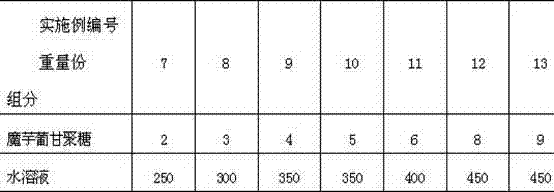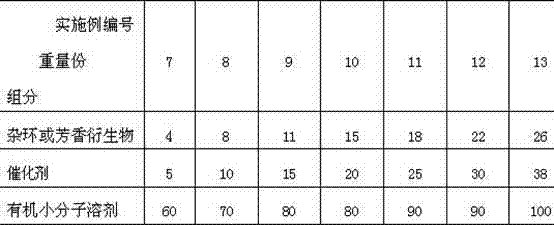Method for preparing absorbing material based on modified konjac glucomannan
A technology of konjac glucomannan and adsorption materials, which is applied in the field of preparation of glucomannan derivatives, can solve problems such as high viscosity, small ion adsorption selectivity, and weak coordination ability, and achieve enhanced complexation and adsorption The effect of multiple sites, low production and use costs
- Summary
- Abstract
- Description
- Claims
- Application Information
AI Technical Summary
Problems solved by technology
Method used
Image
Examples
Embodiment 1
[0026] A preparation method of an adsorption material based on modified konjac glucomannan, comprising the following steps:
[0027] 5 parts of konjac fine powder are swelled in 50% acetic acid aqueous solution at 40°C for 12 hours, then vacuum filtered, and then washed with anhydrous acetic acid to remove residual moisture (washed at least three times), and added to 100 parts of phthalic anhydride dissolved in 15 parts In the acetic acid solution, when the reaction temperature was adjusted to 100°C, 20 parts of anhydrous pyridine was quickly added as a catalyst. After reacting for 5 hours, the product was precipitated with 50% ethanol aqueous solution, vacuum filtered after complete precipitation, and the remaining water was washed with ethanol (at least three times). The final product was obtained after the product was dried in a blast oven at 50° C. for 20 hours.
Embodiment 2
[0029] A preparation method of an adsorption material based on modified konjac glucomannan, comprising the following steps:
[0030]Five parts of konjac fine powder are swelled in 50% ethanol aqueous solution at 25°C for 24 hours, then vacuum filtered, and then washed with absolute ethanol to remove residual water (washed at least three times), and added to 100 parts of phthalic anhydride dissolved in 15 parts In the ethanol solution of , when the reaction temperature was adjusted to 100°C, 20 parts of anhydrous pyridine was quickly added as a catalyst. After reacting for 8 hours, the product was precipitated with 50% ethanol aqueous solution, vacuum filtered after complete precipitation, and the remaining water was washed with ethanol (at least three times). The final product was obtained after the product was dried in a blast oven at 50° C. for 20 hours.
Embodiment 3
[0032] A preparation method of an adsorption material based on modified konjac glucomannan, comprising the following steps:
[0033] 5 parts of konjac fine powder were swelled in 50% triethylamine aqueous solution at 50°C for 4 hours, then vacuum filtered, and then washed with anhydrous acetic acid to remove residual water (washed at least three times), and added to 15 parts of o-nitrate dissolved in In 100 parts of acetic acid solution of base phthalic anhydride, when the reaction temperature is adjusted to 100°C, 20 parts of 0.1 sulfuric acid (the solvent is anhydrous acetic acid) is quickly added as a catalyst. After reacting for 8 hours, the product was precipitated with 50% ethanol aqueous solution, vacuum filtered after complete precipitation, and the remaining water was washed with ethanol (at least three times). The final product was obtained after the product was dried in a blast oven at 50° C. for 20 hours.
PUM
 Login to View More
Login to View More Abstract
Description
Claims
Application Information
 Login to View More
Login to View More - R&D
- Intellectual Property
- Life Sciences
- Materials
- Tech Scout
- Unparalleled Data Quality
- Higher Quality Content
- 60% Fewer Hallucinations
Browse by: Latest US Patents, China's latest patents, Technical Efficacy Thesaurus, Application Domain, Technology Topic, Popular Technical Reports.
© 2025 PatSnap. All rights reserved.Legal|Privacy policy|Modern Slavery Act Transparency Statement|Sitemap|About US| Contact US: help@patsnap.com


